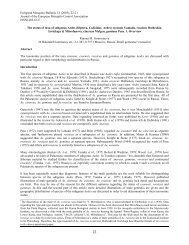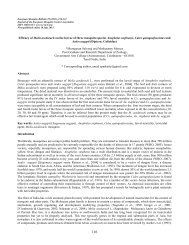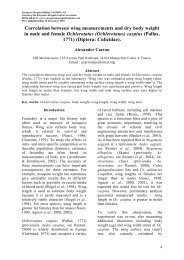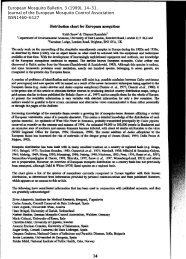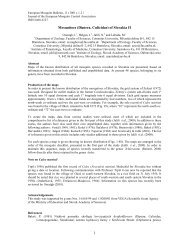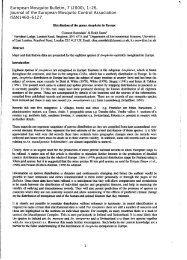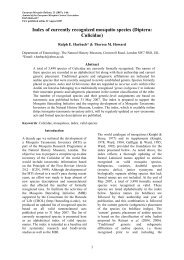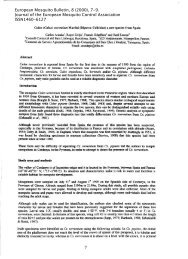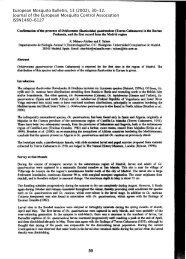European Mosquito Bulletin, 8 (2000), 10-18. Journal of the ...
European Mosquito Bulletin, 8 (2000), 10-18. Journal of the ...
European Mosquito Bulletin, 8 (2000), 10-18. Journal of the ...
Create successful ePaper yourself
Turn your PDF publications into a flip-book with our unique Google optimized e-Paper software.
Since <strong>the</strong> Santander record is based on only 3 adults (Clavero, 1946) and <strong>the</strong> Huelva collection data are unknown<br />
(Gil Collado, 1932a), we regard <strong>the</strong> record as highly doubtful.<br />
<strong>10</strong>. Due to its repeated introduction from North Africa, Aedes aegypti was a common species in Spain during <strong>the</strong><br />
first three decades <strong>of</strong> <strong>the</strong> 1900s. First found in 1899 in Gibraltar, C3diz Province, <strong>the</strong>re are references from 1939<br />
in Barcelona (Margalef 1949, under <strong>the</strong> previous denomination <strong>of</strong> Ae. fasciatus Fabricius) and 1953 (Rico-<br />
Ave1l6y Rico, 1953). Since this previously abundant species has not been found more recently, it is believed to<br />
have disappeared from Spain<br />
11. Several studies still using <strong>the</strong> denomination Cx. molestus for some forms within <strong>the</strong> Culex pipiens complex<br />
have recently been published. Whereas this epi<strong>the</strong>t could be useful for <strong>the</strong> designation <strong>of</strong> physiological variants,<br />
it is invalid from a taXonomicpoint <strong>of</strong>view (Ward, 1992), and <strong>the</strong>refore only Culex pipiens is considered in this<br />
list<br />
12. Culex torrentium is <strong>the</strong> most recently recorded species in Spain (Aranda et al., <strong>2000</strong>). Common in <strong>the</strong> French<br />
Pyrenees (Sicart, 1954),it was first reported from <strong>the</strong> Iberian Peninsula in Portugal (Ribeiro et al., 1977).<br />
13. Culex perexiguus was resurrected from synonymy with Cx. univittatusby Wbite (1975). Harbach (1999)<br />
regarded <strong>the</strong> species <strong>of</strong> <strong>the</strong> unwittatus group found in <strong>the</strong> Mediterranean Subregion as Cr. perexiguus, based on<br />
some specimens from Italy, Greece and Turkey that he had examined. Darsie & Samanidou-Voyadjoglou (1997)<br />
also recognised this taXon as occurring in Greece.However, White (1975) suggested that <strong>the</strong> Spanish reports<br />
referred to Cx. univittatus, and Encinas Grandes (1982) stated that specimens from Salamanca were<br />
unequivocally Cx. unwittatus owing to <strong>the</strong> size <strong>of</strong> <strong>the</strong> ventral arm <strong>of</strong> <strong>the</strong> pballosome. For this reason we are<br />
recognising ex. univittatus as <strong>the</strong> species in Spain.<br />
14. Culex deserticola was recently recorded from Zamgoza Province (Ramos et al., 1998) and this was <strong>the</strong>:first<br />
confirmed record from continental Europe. A previous report by 8eguy from Corsica (1965 in SchafIner, 1998)<br />
was considered unreliable by Schaffner (1998) because <strong>of</strong> lack <strong>of</strong> adults and <strong>the</strong> concurrence <strong>of</strong> <strong>the</strong> similar Cx.<br />
hortensis.<br />
15. Culiseta morsitans has been recorded twice from Spain The:first record was based only on larval specimens,<br />
(Estelles & Mulero, 1949 in Torres Caiiamares, 1979) collected in <strong>the</strong> Llobregat Delta in Barcelona, but <strong>the</strong><br />
species has not been found <strong>the</strong>re in <strong>the</strong> last 18 years. The second report (Qavero, 1950) did not indicate <strong>the</strong><br />
developmental stage, location (not even province) or date. According to Torres Caftamares (1979), <strong>the</strong> male<br />
genitalia are needed to discriminate this species from Cs. litorea. Fur<strong>the</strong>rmore, Torres C.JIfulm~resconsidered <strong>the</strong><br />
presence <strong>of</strong> Cs. morsitans highly doubtful in Spain However, Maslov (1989) gives <strong>the</strong> distribution <strong>of</strong> Cs.<br />
morsitans as "... eveJ)'Wherein Europe, Morocco and Algeria ...", and descn"bessome valid larval characters to<br />
separate <strong>the</strong> species from Cs. litorea.<br />
16. Coquillettidia buxtoni has been collected along <strong>the</strong> Catalan Mediterranean seashore, :first in <strong>the</strong> Emporda<br />
region (Anonymous, 1989; our own data) and later in <strong>the</strong> Baix Llobregat area (1991; our own data).<br />
SPECIES PROBABLY OCCURRING<br />
IN SPAIN<br />
The Iberian Peninsula has a very special location between Europe and Africa. It comprises many climatic areas,<br />
ranging from cold rainy continental climatic areas in <strong>the</strong> north to subdesertic biotopes in <strong>the</strong> south, with wide<br />
intermediate variation It is worth noting that even in <strong>the</strong> :firsthalf <strong>of</strong> <strong>the</strong> 19OOs,during a period <strong>of</strong> exhaustive<br />
sampling, surveys were not uniformly distnbuted across Spain. Most collections were carried out in endemic<br />
areas <strong>of</strong> malaria such as <strong>the</strong> valleys <strong>of</strong> La Mata and La Vera in C8ceres, <strong>the</strong> entire Andalusian region, and <strong>the</strong><br />
Llobregat Delta in Catalonia. O<strong>the</strong>r areas were explored simply because entomologists happened to spend <strong>the</strong>ir<br />
holidays <strong>the</strong>re.<br />
To our knowledge, many provinces have never been extensively sampled. Central <strong>European</strong> species can be<br />
found in colder and rainy regions such as <strong>the</strong> Basque countIy. O<strong>the</strong>r areas, such as <strong>the</strong> relict biotope where Cx.<br />
deserticola was found, should be carefully explored to assess <strong>the</strong> possible occurrence <strong>of</strong> Mediterranean and<br />
North African species like Cx. martinii Medschid, which is scattered from Morocco <strong>10</strong> France and Italy (Knight<br />
& Stone, 1977). Two An. sergentii records in <strong>the</strong> Mediterranean Region (Ramsdale & Snow, 1999), toge<strong>the</strong>r<br />
with <strong>the</strong> occurrence <strong>of</strong> <strong>the</strong> species in <strong>the</strong> Canary Islands, raise <strong>the</strong> possibility <strong>of</strong> its presence in sou<strong>the</strong>rn Spain<br />
14<br />
L



